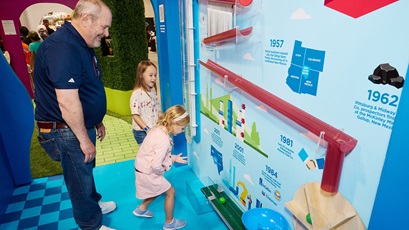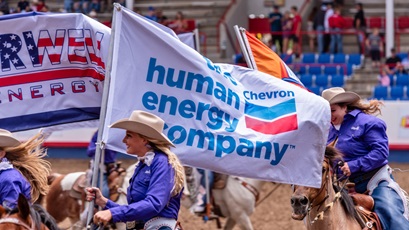people and community
preserving a threatened turtle species
2 min read | february 05, 2025
The Rio Grande cooter is found in the Rio Grande drainage basin, which spans Mexico, New Mexico and Texas. Photo courtesy of the New Mexico BioPark Society.
The next time Christian Isely takes his young daughter, Josefa, to the ABQ BioPark in Albuquerque, New Mexico, they’ll be sure to stop by the habitat where the Rio Grande cooter lives.
This turtle species is designated as threatened—it’s listed by the New Mexico Department of Game & Fish as a “species of greatest conservation need.” And it’s listed as “near threatened” on the International Union for Conservation of Nature’s Red List of Threatened Species.
The Rio Grande cooter is also a focus of conservation efforts involving Chevron, the ABQ BioPark and the New Mexico BioPark Society.
“This support is really crucial,” said Isely, a Chevron state government affairs representative. “Preserving an aquatic species is especially important in New Mexico because it’s such a dry state.”
habitat improvements
In September, Chevron made a three-year financial commitment to, among other things, help support preservation efforts for the Rio Grande cooter, which calls the Rio Grande watershed home.
During the first year, funds will be spent making life a little more comfortable for the turtles that the ABQ BioPark is raising as part of its commitment to safeguarding this threatened species.
This includes the purchase and installation of fiberglass aquatic tanks, and the creation of fortified outdoor areas so the turtles have access to sunlight.
christian isely
new mexico state government affairs representative
return to nature
In 2025, Rio Grande cooter hatchlings born at the facility will be released into the wild. Once they’re freed, the turtles will continue to be researched and monitored, to aid in developing conservation efforts.

Damming, depletion and pollution have critically altered the quantity and quality of the water that the Rio Grande cooter needs for survival. Photo courtesy of the New Mexico BioPark Society.
more on that
Chevron’s $200,000-per-year commitment to helping New Mexico’s wildlife thrive is meant not only to support the preservation of the Rio Grande cooter, but also to support conservation and education efforts related to native plants, butterflies and other insects.
For example, the ABQ BioPark is creating specialized environments to house collections of native New Mexico plants. Its goal is to support the plants’ growth and reintroduction into nature.
The facility is also planning to add a controlled breeding area for threatened species of butterflies.
topics covered
related content
-

 supporting STEM education in new mexico
supporting STEM education in new mexicopeople and communitynovember 18, 2025
-

 frontline innovations drive business solutions
frontline innovations drive business solutionspeople and communitynovember 12, 2025
-

 the people who power the US energy advantage
the people who power the US energy advantageour operationsnovember 06, 2025
-

 greeley stampede is riding high, with chevron’s support
greeley stampede is riding high, with chevron’s supportpeople and communityaugust 18, 2025
chevron email updates
Subscribe to our newsletter to receive news and updates.



